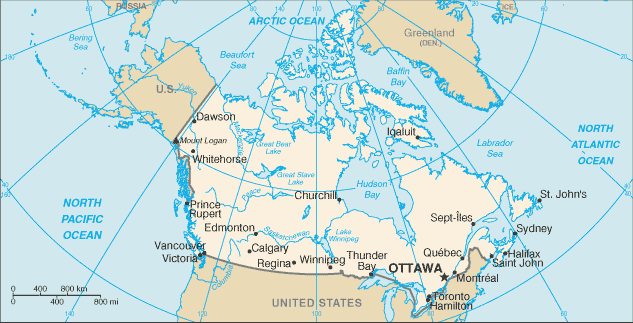Map:

Overview:
A land of vast distances and rich natural resources, Canada became a self-governing dominion in 1867 while retaining ties to the British crown. Economically and technologically the nation has developed in parallel with the US, its neighbor to the south across an unfortified border. Canada's paramount political problem is meeting public demands for quality improvements in health care and education services after a decade of budget cuts. The issue of reconciling Quebec's francophone heritage with the majority anglophone Canadian population has moved to the back burner in recent years; support for separatism abated after the Quebec government's referendum on independence failed to pass in October of 1995.
The People:
Population: 32,805,041 (July 2005 est.)
Age structure:
0-14 years: 17.9% (male 3,016,032/female 2,869,244)
15-64 years: 68.9% (male 11,357,425/female 11,244,356)
65 years and over: 13.2% (male 1,842,496/female 2,475,488) (2005 est.)
Religions:
Roman Catholic 42.6%, Protestant 23.3% (including United Church 9.5%, Anglican 6.8%, Baptist 2.4%, Lutheran 2%), other Christian 4.4%, Muslim 1.9%, other and unspecified 11.8%, none 16% (2001 census)
Government Type:
confederation with parliamentary democracy
Leader(s) to pray for:
chief of state: Queen ELIZABETH II (since 6 February 1952), represented by Governor General Adrienne CLARKSON (since 7 October 1999)
head of government: Prime Minister Paul MARTIN (since 12 December 2003); Deputy Prime Minister Anne MCLELLAN (since 12 December 2003)
Source: The World Factbook
View All Countries